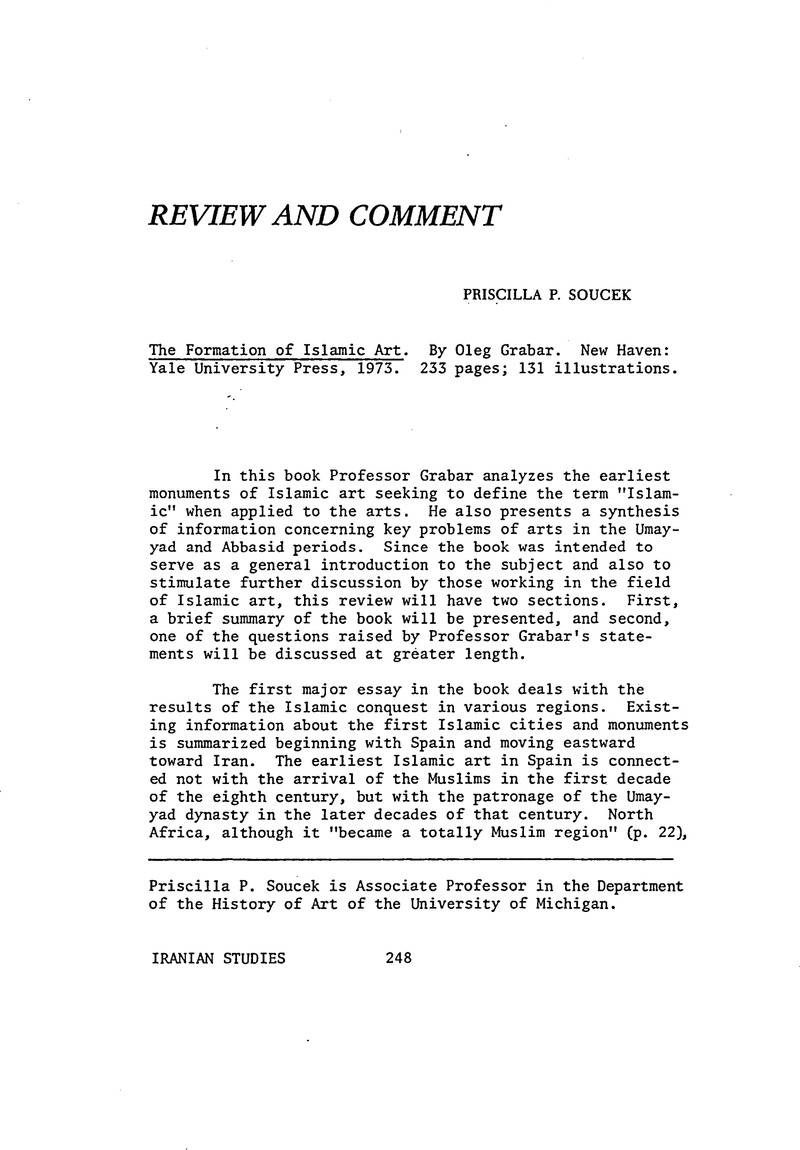Article contents
The Formation of Islamic Art. By Oleg Grabar. New Haven: Yale University Press, 1973. 233 pages; 131 illustrations.
Published online by Cambridge University Press: 01 January 2022
Abstract

- Type
- Review and Comment
- Information
- Copyright
- Copyright © Association For Iranian Studies, Inc 1975
References
Notes
1. Hamilton, R. W. Khirbat al-Mafjar, Oxford, 1959, pp. 98-103Google Scholar, fig. 52, p1. LV; L,5; CVII.
2. Ibid., fig. 50.
3. Ibid., pp. 92-98, p1. LVI, CVIII.
4. Ibid., pp. 63-67, figs. 25, 26, p1s. LIII, LIV, LVI.
5. Jarīr al-Ṭabarī, Muḥammad ibn Jāmi˓ al-Bayān, Cairo, 1954, vol. 22, pp. 71-72.Google Scholar
6. Aḥmad al-Muqaddasī, Muḥammad b. Aḥsan al-Taqāsīm fi Ma˓rifat al-Aqālīm, ed. de Goeje, 2nd ed., Leiden, 1906, p. 444: 6-10.Google Scholar
7. Ṭāhir al-Maqdisī, Mutahhar ibn Kitāb al-Bad’ wa al-Tā'rīkh, Paris, 1903, vol. III, p. 106.Google Scholar
8. Muḥammad Bal˓amī, Tā'rīkh-i Ṭabarī, trans. Zotenberg, Paris, 1958, vol. I, p. 442.Google Scholar
9. Aḥmad al-Ḥamdānī, al-Ḥasan ibn The Antiquities of South Arabia, trans. Faris, N. Princeton, 1938, p. 50.Google Scholar
10. ˓Alī Al-Harawī, Kitāb al-Ishārāt ilā Ma˓rifat al-Ziyārāt, ed. Sourdel-Thomine, J. Damascus, 1953, p. 21.Google Scholar
11. Ṭabarī, Jāmi˓ al-Bayān, vol. 22, p. 69.Google Scholar
12. Ṭabarī, Tā'rīkh al-Rusul wa al-Mulūk, ed. de Goeje, Leiden, 1881-82, vol. I, pt. 2, p. 575:2-11.Google Scholar
13. Ettinghausen, R. From Byzantium to Sasanian Iran and the Islamic World, Leiden, 1972, pp. 11-16.Google Scholar
14. ˓Alī b. al-Ḥusain al-Mas˓ūdī, Murūj al-Dhahab, ed. Pavet de Courteille Barbier de Meynard, Paris, 1914, vol. 4, p. 23.Google Scholar
15. Ibn Isḥāq/ Ibn Hishām, Sīrat al-Nabī, Cairo, 1971, Vol. II, p. 6.Google Scholar
16. Dā'īd al-Dīnawarī, Aḥmad ibn Akhbār al-Ṭiwāl, Cairo, 1970, p. 19:9-10.Google Scholar
17. Ṭabarī, Tā'rīkh, vol. I, pt. 2, p. 573:1-2, 575:11 576:2.Google Scholar
18. For a canopy supported by angels, see Fares, B. “Figures Magiques,” fig. 2, in Aus der Welt der Islamischen Kunst, ed. Ettinghausen, R. Berlin, 1959Google Scholar; for a bird canopy see Stchoukine, I. Les Peintures des Manuscrits Safavis, Paris, 1959, p1. LXV.Google Scholar
19. Tabarī gives two versions of this story--in both cases Solomon loses the ring because he entrusts it to one of his wives who gives it to the usurper. The ring is eventually recovered from the stomach of a fish. Tā'rīkh, vol. I, pt. 2, pp. 589:18, 594:3.Google Scholar
20. For a detailed description, see Abū ˓Alī al-Faḍl al-Tabarsī, Majma˓ al-Bayān, Cairo, 1955, vol. 22, pp. 191-192.Google Scholar The figure of Solomon (discussed by B. Fares) cited in note 18 is supported by lions. See also Binyon, L. Wilkinson, J. V. S. Gray, B. Persian Miniature Painting, Oxford, 1933, p1. XVI B.Google Scholar
21. Miskawaih, Ibn Tajārib al-Umam, ed. and trans. Amedroz, H. and Margoliouth, D. Oxford, 1921, vol. I, pp. 162-163, vol. IV, pp. 182-183.Google Scholar
22. Mīr Muḥammad ibn Sayyīd Burhān al-Dīn Khwāvand Shāh known as Mirkhwānd, Tā'rīkh Rawzat al-Ṣafā, Tehran, 1339, vol. IV, p. 154.Google Scholar
- 2
- Cited by


